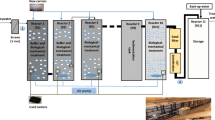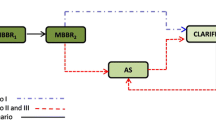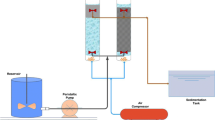Abstract
Optimization of biofilm activated sludge (BAS) process via mathematical modelling is an entangle activity since economic, environmental objective and technical decision must be considered. This paper presents a methodology to optimize the operational conditions of BAS process in four steps by combining dynamic simulation techniques with non-linear optimization methods and with operative decision-making criteria. Two set of variables are separately prioritized in the methodology: essential variables related to physical operation to enforce established process performance, and refinement variables related to biological processes that can generate risks of bulking, pin-point floc and rising sludge. The proposed optimization strategy is applied for the treatment of high COD wastewater under nutrient limitation using an integrated mathematical model for COD removal that include predation, hydrolysis and a simplified approach to the limiting solids flux theory in the secondary clarifier in order to facilitate the convergence of the optimization solver. The methodology is implemented in a full-scale wastewater treatment plant for a cellulose and viscose fibre mill obtaining (i) improvement of the effluent quality index (Kg pollution/m3) up to 62% and, (ii) decrease the operating cost index (€/m3) of the process up to 30% respect the regular working operational conditions of the plant. The proposed procedure can be also applied to other biological treatments treating high COD nutrient-limited industrial wastewater such as from textile and winery production among others.

ᅟ








Similar content being viewed by others
Abbreviations
- A:
-
Surface area of the secondary settler (m2)
- AS:
-
Activated sludge process
- BAS:
-
Biofilm activated sludge process
- BOD:
-
Biological oxygen demand (g/m3)
- CD:
-
Aeration energy associated to the carbonaceous demand (KWh/day)
- COD:
-
Chemical oxygen demand (g/m3)
- EQI:
-
Effluent quality index (Kg pollution/m3)
- GL:
-
Limiting solid flux (Kg TSS/m2 hour)
- HLR:
-
Hydraulic loading rate in secondary settler (m3/m2 hour)
- HRT:
-
Hydraulic retention time in activated sludge rector (hours)
- K:
-
Coefficient for each settleability range (m3/Kg)
- m:
-
Coefficient for each settleability range
- MBBR:
-
Moving bed biofilm reactor
- ME:
-
Mixing energy (KWh/day)
- n:
-
Coefficient for each settleability range (m3/Kg)
- NC:
-
Nutrient cost (€/year)
- ND:
-
Aeration energy associated to the nitrogenous demand (KWh/day)
- NO:
-
Nitrate concentration (g/m3)
- OCI:
-
Operating cost index (€/m3)
- P:
-
Phosphorous concentration (g/m3)
- PE:
-
Pumping energy (KWh/day)
- Q:
-
Flow rate (m3/day)
- R:
-
Sludge recycle ratio (%)
- SLR:
-
Solid loading rate (Kg TSS/m2 hour)
- SP:
-
Sludge production (Tn TSS/day)
- SRT:
-
Sludge retention time in activated sludge rector (days)
- SVI:
-
Sludge volume index (mL/g)
- TCI:
-
Total cost index (€/m3)
- TN:
-
Total nitrogen concentration (g/m3)
- TSS:
-
Total suspended solids concentration (g/m3)
- TSSAS :
-
Total suspended solids concentration in activated sludge reactor (g/m3)
- TSSW :
-
Total suspended solids concentration in sludge wastage stream (g/m3)
- TKN:
-
Total Kjeldahl nitrogen concentration (g/m3)
- v:
-
Sludge settling velocity (m3/m2 hour)
- vo:
-
Coefficient for each settleability range (m/hour)
- νd:
-
Hydraulic retention time in the secondary settler (hours)
- e:
-
Effluent
- f:
-
Filtered
- i:
-
Influent
- R:
-
Sludge recycled
- W:
-
Sludge wastage
References
Amanatidou, E., Samiotis, G., Trikoilidou, E., Pekridis, G., & Taousanidis, N. (2015a). Evaluating sedimentation problems in activated sludge treatment plants operating at complete sludge retention time. Water Research, 69, 20–29. https://doi.org/10.1016/j.watres.2014.10.061.
Amanatidou, E., Samiotis, G., Bellos, D., & Pekridis, G. (2015b). Net biomass production under complete solids retention in high organic load activated sludge process. Bioresource Technology, 182, 492–502.
Bakos, V., Kiss, B., & Jobbágy, A. (2016). Problems and causes of marginal nutrient availability in winery wastewater treatment. Acta Alimentaria, 45(4), 532–541.
Boltz, J. P., Smets, B. F., Rittmann, B. E., Van Loosdrecht, M. C., Morgenroth, E., & Daigger, G. T. (2017). From biofilm ecology to reactors: a focused review. Water Science and Technology, 75(8), 1753-1760.
Chen, W., Lu, X., & Yao, C. (2015). Optimal strategies evaluated by multi-objective optimization method for improving the performance of a novel cycle operating activated sludge process. Chemical Engineering Journal, 260, 492–502. https://doi.org/10.1016/j.cej.2014.08.087.
Comas, J., Rodríguez-Roda, I., Sànchez-Marrè, M., Cortés, U., Freixó, A., Arráez, J., & Poch, M. (2003). A knowledge-based approach to the deflocculation problem: integrating on-line, off-line, and heuristic information. Water Research, 37(10), 2377–2387. https://doi.org/10.1016/S0043-1354(03)00018-6.
Comas, J., Rodríguez-Roda, I., Gernaey, K. V., Rosen, C., Jeppsson, U., & Poch, M. (2008). Risk assessment modelling of microbiology-related solids separation problems in activated sludge systems. Environmental Modelling and Software, 23(10–11), 1250–1261. https://doi.org/10.1016/j.envsoft.2008.02.013.
Comeau, Y., Peteesen, B., Stuart, P., Perkier, M., Graff, S., & Asselin, C. (2003). Activated sludge yield reduction by the low sludge production (LSP) process results are promising. Pulp and Paper Canada, 104(8), 40–42.
Copp, J. B. (2002). The COST simulation benchmark. Description and simulator manual. Luxembourg: Office for Official Publications of the European Communities.
Dai, H., Chen, W., & Lu, X. (2016). The application of multi-objective optimization method for activated sludge process: a review. Water Science and Technology, 73(2), 223–235. https://doi.org/10.2166/wst.2015.489.
Descoins, N., Deleris, S., Lestienne, R., Trouvé, E., & Maréchal, F. (2012). Energy efficiency in waste water treatments plants: optimization of activated sludge process coupled with anaerobic digestion. Energy, 41(1), 153–164. https://doi.org/10.1016/j.energy.2011.03.078.
El Shorbagy, W., Nabil, N., & Droste, R. L. (2013). Optimization of A20 BNR processes using ASM and EAWAG models: model performance. Water Environment Research, 85(12), 2271–2284. https://doi.org/10.2175/106143013X13596524517102.
Espírito Santo, I. A. C. P., Costa, L., & Fernandes, E. M. G. P. (2013). On optimizing a WWTP design using multi-objective approaches. Engineering Letters, 21(4), 193–202.
Fan, C., Kao, C. F., & Liu, Y. H. (2017). Quantitative characterization of organic diffusion using an analytical diffusion-reaction model and its application to assessing BOD removal when treating municipal wastewater in a plug flow reactor. Water Research, 121, 329–337. https://doi.org/10.1016/j.watres.2017.05.050.
Flores-Alsina, X., Rodríguez-Roda, I., Sin, G., & Gernaey, K. V. (2008). Multi-criteria evaluation of wastewater treatment plant control strategies under uncertainty. Water Research, 42(17), 4485–4497. https://doi.org/10.1016/j.watres.2008.05.029.
Flores-Alsina, X., Comas, J., Rodriguez-Roda, I., Gernaey, K. V., & Rosen, C. (2009). Including the effects of filamentous bulking sludge during the simulation of wastewater treatment plants using a risk assessment model. Water Research, 43(18), 4527–4538. https://doi.org/10.1016/j.watres.2009.07.033.
Flores-Alsina, X., Gallego, A., Feijoo, G., & Rodriguez-Roda, I. (2010). Multiple-objective evaluation of wastewater treatment plant control alternatives. Journal of Environmental Management, 91(5), 1193–1201. https://doi.org/10.1016/j.jenvman.2010.01.009.
Foscoliano, C., Del Vigo, S., Mulas, M., & Tronci, S. (2016). Predictive control of an activated sludge process for long term operation. Chemical Engineering Journal, 304, 1031–1044.
Freedman, D. L., Payauys, A. M., & Karanfil, T. (2005). The effect of nutrient deficiency on removal of organic solvents from textile manufacturing wastewater during activated sludge treatment. Environmental Technology, 26(2), 179–188. https://doi.org/10.1080/09593332608618570.
Garrido-Baserba, M., Reif, R., Molinos-Senante, M., Larrea, L., Castillo, A., Verdaguer, M., & Poch, M. (2016). Application of a multi-criteria decision model to select of design choices for WWTPs. Clean Technologies and Environmental Policy, 18(4), 1097–1109. https://doi.org/10.1007/s10098-016-1099-x.
Gray, N. F. (2004). Biology of wastewater treatment (2nd ed.). Dublin: World Scientific.
Guerrero, J., Guisasola, A., Vilanova, R., & Baeza, J. A. (2011). Improving the performance of a WWTP control system by model-based setpoint optimisation. Environmental Modelling and Software, 26(4), 492–497. https://doi.org/10.1016/j.envsoft.2010.10.012.
Hakanen, J., Miettinen, K., & Sahlstedt, K. (2011). Wastewater treatment: new perspectives provided by interactive multiobjective. Decision Support Systems, 51(328), 337.
Hakanen, J., Sahlstedt, K., & Miettinen, K. (2013). Wastewater treatment plant design and operation under multiple conflicting objective functions. Environmental Modelling & Software, 46, 240–249. https://doi.org/10.1016/j.envsoft.2013.03.016.
Henze, M. (2008). Modeling of aerobic wastewater treatment processes. In Biotechnology (Vol. 11–12, pp. 417–427). Wiley. https://doi.org/10.1002/9783527620999.ch20l.
Henze, M., Dupont, R., Grau, P., & de la Sota, A. (1993). Rising sludge in secondary settlers due to denitrification. Water Research, 27(2), 231–236. https://doi.org/10.1016/0043-1354(93)90080-2.
Hreiz, R., Latifi, M. A., & Roche, N. (2015a). Optimal design and operation of activated sludge processes: state-of-the-art. Chemical Engineering Journal, 281, 900–920. https://doi.org/10.1016/j.cej.2015.06.125.
Hreiz, R., Roche, N., Benyahia, B., & Latifi, M. A. (2015b). Chemical engineering research and design multi-objective optimal control of small-size wastewater treatment plants. Chemical Engineering Research and Design, 102, 345–353. https://doi.org/10.1016/j.cherd.2015.06.039.
Hussain, A., Kumar, P., & Mehrotra, I. (2015). Nitrogen and phosphorus requirement in anaerobic process: a review. Environmental Engineering and Management Journal, 14(4), 769–780.
Kamali, M., & Khodaparast, Z. (2015). Review on recent developments on pulp and paper mill wastewater treatment. Ecotoxicology and Environmental Safety, 114, 326–342. https://doi.org/10.1016/j.ecoenv.2014.05.005.
Kim, M., Kim, M.-J., Pyo, S.-H., Lee, S.-C., Ghorbannezhad, P., Foo, D. C. Y., & Yoo, C.-K. (2015). Greenhouse emission pinch analysis (GEPA) for evaluation of emission reduction strategies. Clean Technology and Environmental Policy, 18(5), 1381–1389.
Li, B., Qiu, Y., Zhang, C., Chen, L., & Shi, H. (2016). Understanding biofilm diffusion profiles and microbial activities to optimize integrated fixed-film activated sludge process. Chemical Engineering Journal, 302, 269–277. https://doi.org/10.1016/j.cej.2016.05.048.
Malmqvist, Å., Welander, T., & Olsson, L. E. (2007). Long term experience with the nutrient limited BAS process for treatment of forest industry wastewaters. Water Science and Technology, 55(6), 89–97.
Rankin, A., Aert, M. V. A. N., & Welander, T. (2007). Low sludge yield biofilm activated sludge ( BAS ) upgrade – Quesnel River Pulp. Tappi Journal, 6(5), 17–22.
Revilla, M., Galán, B., & Viguri, J. R. (2016a). Analysis and modelling of predation on biofilm activated sludge process: influence on microbial distribution, sludge production and nutrient dosage. Bioresource Technology, 220, 572–583. https://doi.org/10.1016/j.biortech.2016.08.107.
Revilla, M., Galán, B., & Viguri, J. R. (2016b). An integrated mathematical model for chemical oxygen demand (COD) removal in moving bed biofilm reactors (MBBR) including predation and hydrolysis. Water Research, 98, 84–97. https://doi.org/10.1016/j.watres.2016.04.003.
Rivas, A., Irizar, I., & Ayesa, E. (2008). Model-based optimisation of wastewater treatment plants design. Environmental Modelling and Software, 23(4), 435–450. https://doi.org/10.1016/j.envsoft.2007.06.009.
Sointio, J., Rankin, A., & van Aert, M. (2006). Biofilm activated sludge process at Quesnel River Pulp installation. Environmental Science & Engineering Magazine, November, 22–24.
Sweetapple, C., Fu, G., & Butler, D. (2014). Multi-objective optimisation of wastewater treatment plant control to reduce greenhouse gas emissions. Water Research, 55(0), 52–62. https://doi.org/10.1016/j.watres.2014.02.018.
Tchobanoglous, G., Burton, F. L., & Stensel, H. D. (2003). Wastewater engineering: treatment and reuse. New York City: McGrawHill Education.
van Haandel, A.,& van der Lubbe, J. (2012). Handbook of biological wastewater treatment. 2nd ed.; IWA Publishing: London, UK.
Vanrolleghem, P. A., & Gillot, S. (2002). Robustness and economic measures as control benchmark performance criteria. Water Science and Technology, 45(4–5), 117–126.
von Sperling, M. (2007). Activated sludge and aerobic biofilm reactors. IWA publishing. https://doi.org/10.2166/9781780402123.
Welander, T., Olsson, L. E., & Fasth, C. (2002). Nutrient-limited biofilm pretreatment: an efficient way to upgrade activated sludge plants. Tappi Journal, 1(4), 20–26.
Zhou, Z., Shen, X., Jiang, L. M., Wu, Z., Wang, Z., Ren, W., & Hu, D. (2015). Modeling of multimode anaerobic/anoxic/aerobic wastewater treatment process at low temperature for process optimization. Chemical Engineering Journal, 281, 644–650. https://doi.org/10.1016/j.cej.2015.07.017.
Acknowledgements
The authors would like to thank SNIACE Company for their help and support during the wastewater sampling and characterization at industrial plant.
Author information
Authors and Affiliations
Corresponding author
Additional information
Highlights
• A novel optimization methodology for biofilm activated sludge (BAS) is proposed
• Our BAS model includes a simplified approach to the limiting solid flux theory
• Combination of simulation and optimization tools overtakes the mathematical challenge
• Economic, effluent quality and technical criteria are included in the methodology
• Reductions up to 25% of cost and 62% of pollution are obtained at optimal condition
Rights and permissions
About this article
Cite this article
Revilla, M., Galán, B. & Viguri, J.R. Optimization Methodology for High COD Nutrient-Limited Wastewaters Treatment Using BAS Process. Water Air Soil Pollut 229, 191 (2018). https://doi.org/10.1007/s11270-018-3835-9
Received:
Accepted:
Published:
DOI: https://doi.org/10.1007/s11270-018-3835-9




